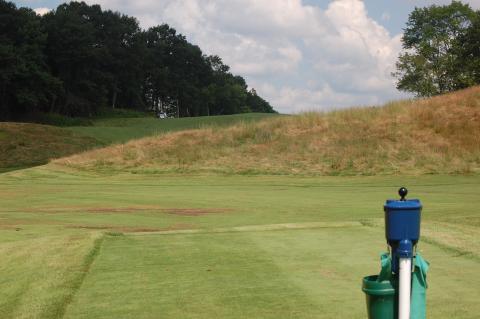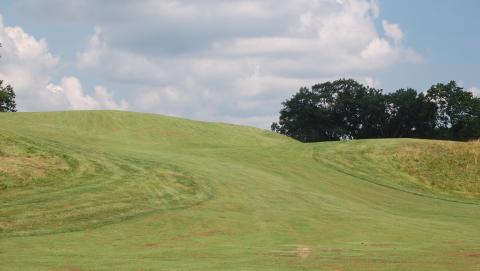I have a love/hate relationship with Yale Golf Club in New Haven, CT. Don't ask too many questions. It's complicated.
Yale is one of classic architect Seth Raynor's many famous designs, and its first hole gives only a mere hint of its complex personality. Hit your tee shot over a canyon, and a simple looking short-to-mid iron approach to a green big enough to land a B-29 on will have you thinking, "What's all the fuss about?" That green, though, is divided left and right by a canyon of its own; put your ball on the wrong side and you will feel like filing divorce papers right away. And that is not the toughest, most bizarrely contoured green on the course, not by a long shot.
Much
about the Yale golf course is bizarre, but not in a way that forces you to shun
its charms and run for the hills, of which there are many to choose. Yale's sassiness is in its terrain, its
greens, and its attitude of take me as I am, and if you don't like it, well
then we don't care where your diploma is from (the club is primarily for Yale
alumni, but accommodations can be made if you know someone).
of which there are many to choose. Yale's sassiness is in its terrain, its
greens, and its attitude of take me as I am, and if you don't like it, well
then we don't care where your diploma is from (the club is primarily for Yale
alumni, but accommodations can be made if you know someone).
A blind golfer would be at only a modest disadvantage on some tee shots and many approach shots at Yale. Even if you have played the course dozens of times, the tall poles with flags bearing the clubs' insignia provide only general directional assistance, as at the par 4 3rd. The hole is simply but aptly named "Blind," where a thread-the-needle drive between gorse and lake is rewarded with just a wedge approach. But Yale turns out to be an Indian giver at the 3rd and elsewhere because that approach shot is over a two-story-high hill to a totally hidden green. A perfect approach shot may land pin high, but that could mean up to a 50-foot putt -- straight downhill.

Flying blind: The tall flagpole behind the 3rd green provides only general directions to the green.
To anyone who hasn't played Yale, this is going to sound farfetched, but on a couple of greens, a player just a few inches shorter than, say, pro golfer Jeff Sluman could actually have a blind putt. On the signature par 3 9th, for example, the mown crevice that separates the back from the front part of the 70-yard long green is a good five feet deep. Pin front...tee shot back...good night Irene. Pin back...tee shot front...make sure you bring enough club. Seriously, if club officials aren't looking, lob wedge could be the best play from one tier to the other. And did I mention that the 213-yard tee shot is all carry over a canyon filled with muck and mire, caseloads of ProV1s and not a few golf clubs?
Unless you never make a bad swing through 18 holes, good enough is not good enough at Yale. One slightly pulled or pushed shot can put you in a signature Raynor greenside bunker, which is to say severely and steeply faced but narrow enough that your ball could bump up against one lip or the other. The sides of some greens are so steep that steps are provided for your convenience, about the only accommodation the course makes for errant shots.
Shorter par 4s, like the 396-yard
10th, build in their challenges with slightly narrower (and sloped)
fairways and  approach shots straight up to greens. Your ball had better stay on the putting surface or you face
dire consequences. (Notice I wrote
"stay on"; landing on them is no guarantee of a putt, as the more elevated greens
tend to be among the firmest).
Indeed, at the 10th there are two ways to make bogey,
assuming your tee shot doesn't veer off into the woods on either side (double
bogey territory): You can land
short and bury against a hill the height of a New York City apartment building,
or go just off the back of the green into rough deeper and thicker than Don
King's hairdo. The chip from there
is straight downhill, by the way.
approach shots straight up to greens. Your ball had better stay on the putting surface or you face
dire consequences. (Notice I wrote
"stay on"; landing on them is no guarantee of a putt, as the more elevated greens
tend to be among the firmest).
Indeed, at the 10th there are two ways to make bogey,
assuming your tee shot doesn't veer off into the woods on either side (double
bogey territory): You can land
short and bury against a hill the height of a New York City apartment building,
or go just off the back of the green into rough deeper and thicker than Don
King's hairdo. The chip from there
is straight downhill, by the way.
If you have struck the ball exquisitely well on the first 17 holes, accepted your medicine on a few of them, and gotten past the one or two inevitable three-putts without snapping the putter over your knee (or doing damage to the greens), it is possible to have a comfortable little round going at Yale. But then you play the 18th hole, and this is where the hate part comes in. Raynor's finishing hole is incomprehensibly penal -- disharmonious with the preceding 17 holes and, indeed, with virtually all the other millions of holes across the land. (Okay, I haven't played them all, but I've played more than 6,000, and nothing in my experience matches the 18th at Yale.) Unique it is, but so difficult you could swear someone on the 18th tee pasted a "Hit me" sign onto your back when you weren't looking.
It pains me even to relive the hole
in words, but here goes: The blind
drive on the par 5 621-yarder is over a hill to a notch of fairway cut to the
left of and over the hill. A tee
shot a little short, a little long, or a little right and you will be hitting
out of gorse, with your ball, quite possibly, at eye level. Assuming you can advance the ball
normally, the lay-up shot with a fairway metal or hybrid is yet another blind
shot, up over a nearly vertical swatch of fairway. Past that hill, your perfectly struck lay-up shot will hit
one side or the other of a large mound that runs through the middle of the
fairway downhill toward the green.
Land on the left side of the mound, and your ball will bound into the
rough or trees to the left. Hit
the right side of the mound, and you can count on your third shot coming from
the thick rough to the right of the fairway. The luckiest (and longest and straightest) players will hit
the back end of the mound and bound down the hill, more or less toward salvation, leaving a long pitch shot to a deep green.
notch of fairway cut to the
left of and over the hill. A tee
shot a little short, a little long, or a little right and you will be hitting
out of gorse, with your ball, quite possibly, at eye level. Assuming you can advance the ball
normally, the lay-up shot with a fairway metal or hybrid is yet another blind
shot, up over a nearly vertical swatch of fairway. Past that hill, your perfectly struck lay-up shot will hit
one side or the other of a large mound that runs through the middle of the
fairway downhill toward the green.
Land on the left side of the mound, and your ball will bound into the
rough or trees to the left. Hit
the right side of the mound, and you can count on your third shot coming from
the thick rough to the right of the fairway. The luckiest (and longest and straightest) players will hit
the back end of the mound and bound down the hill, more or less toward salvation, leaving a long pitch shot to a deep green.
The first 17 holes at Yale make you work hard to keep yourself from tearing up the scorecard. Your reward for the pleasant exhaustion you feel coming to the final hole is a par 5 ugly monster (and I mean that in the sense of Godzilla rather than in length) that will wring every last ounce of energy from you. I think I love Yale Golf Club because it is not like any other course I know, but I hate that 18th hole. No matter how many times I visit Yale, the song remains the same: "Love hurts."



Prayers for the blind: The tee shot on #18 must find a notch in the fairway (top), or hills of tall and gnarly grass scream bogey, or worse. A second blind shot must be straight over the center of a steep hill (middle) to have any chance of finding the fairway which, if Lady Luck is with you, will leave you with the opportunity to exhale and then hit a rather simple wedge or pitch shot to the large green. Your after-round drink will either drown your sorrows or celebrate your survival.



